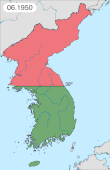Battle of Masan
However, the 24th Infantry performed very poorly at the battles of Blue Mountain and Haman, forcing the 25th Division to muster reserves to counter the KPA gains against the 24th.
The United States subsequently committed ground forces to the Korean peninsula with the goal of fighting back the KPA invasion and preventing South Korea from collapsing.
It would kick off with an attack by the US reserve units in the Masan area to secure Chinju from the KPA 6th Division, followed by a larger general push to the Kum River in the middle of the month.
[18] The plan of attack required the force to move west from positions held near Masan, seize the Chinju Pass, and secure the line as far as the Nam River.
F4U Corsairs from the 1st Marine Air Wing strafed the retreating column repeatedly, inflicting 200 casualties and destroying about 100 of the regiment's equipment vehicles.
[35] Both KPA and US armor swarmed to the scene and US Marine aviation continued to provide air cover, but neither side was able to make appreciable gains despite inflicting heavy casualties on one another.
The 2,000-foot (610 m) mountain ridges of Sobuk-san dominated the area and protected the Komam-ni-Haman-Chindong-ni road, the only means of north-south communication west of Masan.
UN naval forces heavily shelled T'ongyong as three companies of South Korean Marines from Koje Island made an amphibious landing near the town.
[45] The reinforced KPA had advanced on the 25th Infantry Division defensive line and had begun a series of probing attacks that were to continue throughout the month, sometimes of battalion strength.
There the 6th Division attacked any UN-held terrain features that afforded observation of its supply and concentration area in the deeply cut valley to the west.
Employing no artillery or mortar preparatory fires, the force cut the barbed wire at the perimeter and attacked at close quarters with small arms and grenades.
[43] From P'il-bong the crest of the ridge line curves northwestward, to rise again 1 mile (1.6 km) away in the bald peak designated Hill 665, which became known as Battle Mountain.
At the same time, from Battle Mountain the KPA could look down into the Haman valley eastward and observe the US 24th Infantry command post, supply road, artillery positions, and approach trails.
On the basis of this misinformation, American artillery and mortars fired concentrations on C Company's former position, and fighter-bombers, in 38 sorties, attacked the crest of Battle Mountain, using napalm, fragmentation bombs, rockets and machine guns.
This action forced the company commander and his remaining 25 men off Battle Mountain after they had held it for 20 hours,[53] having declined a call to surrender from the KPA.
During the day of fighting on Battle Mountain and P'il-bong, the KPA drove off the ROK police from the 24th Infantry's left flank on Sobuk-san.
Artillery, mortar, and tank fire raked the crest and air strikes employing napalm blanketed the top of the peak.
[59] Aerial reconnaissance in the last week of August had disclosed to Eighth Army a large amount of KPA activity behind the lines opposite the US 2nd and 25th Divisions in the southern part of the Pusan Perimeter.
[61] In the left center of the 25th Division line, Lieutenant Colonel Paul F. Roberts' 2nd Battalion, 24th Infantry, held the crest of the second ridge west of Haman, 1 mile (1.6 km) from the town.
[64] South of the pass, at dawn, First Lieutenant Houston M. McMurray found that only 15 out of 69 men assigned to his platoon remained with him, a mix of US and ROK troops.
[65] Thus, shortly after daylight the scattered and disorganized men of the 1st and 2nd Battalions, 24th Infantry had fled to the high ground 2 miles (3.2 km) east of Haman.
[72] For 30 minutes US Air Force aircraft struck KPA positions around Haman with bombs, napalm, rockets, and machine gun fire.
KPA in force held the ridge on the west side of the town, and their machine gun fire swept every approach, destroying one tank and the attacking infantry suffered heavy casualties.
[76] Other KPA soldiers crossed the Nam on an underwater bridge in front of the paddy ground north of Komam-ni and near the boundary between the 2nd Battalion, led by Lieutenant Colonel John L. Wilkins, Jr., holding the river front and Lieutenant Colonel Bernard G. Teeter's 1st Battalion holding the hill line that stretched from the Nam River to Sibidang-san and the Chinju-Masan highway.
[77] In the low ground between these two battalions at the river ferry crossing site, the 35th Infantry commander had placed 300 ROK Police, expecting them to hold there long enough to serve as a warning for the rest of the forces.
But the KPA did not drive for the Komam-ni road fork 4 miles (6.4 km) south of the river as Colonel Fisher expected them to; instead, they turned east into the hills behind 2nd Battalion.
[79] During the morning hours of September 1, when the KPA 7th Division troops had attacked, the first American unit they encountered was G Company, 35th Infantry, at the north shoulder of the gap.
Tanks and armored cars drove to the isolated units with supplies of food and ammunition and carried back critically wounded on the return trips.
Kean considered the situation so dangerous that he ordered Masan evacuated of all people except police, public officials, railroad and utility workers, and necessary laborers and their families.
[89] The battle itself was tactically inconclusive, as neither side was able to decisively defeat the other, however the UN units achieved their strategic goal of preventing the KPA from advancing further east and threatening Pusan.












Chinese and
Soviet forces
• South Korean, U.S.,
Commonwealth
and United Nations
forces